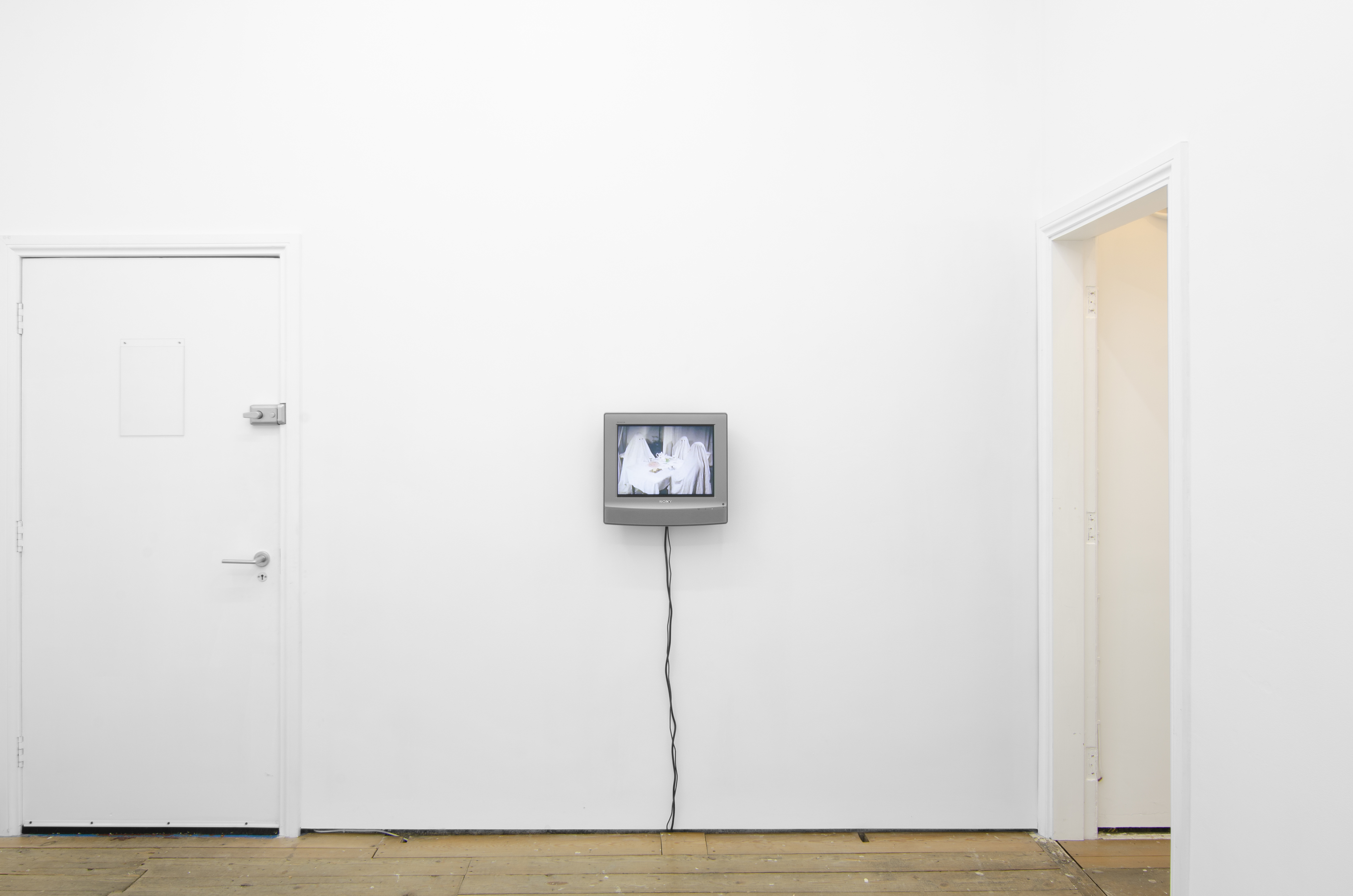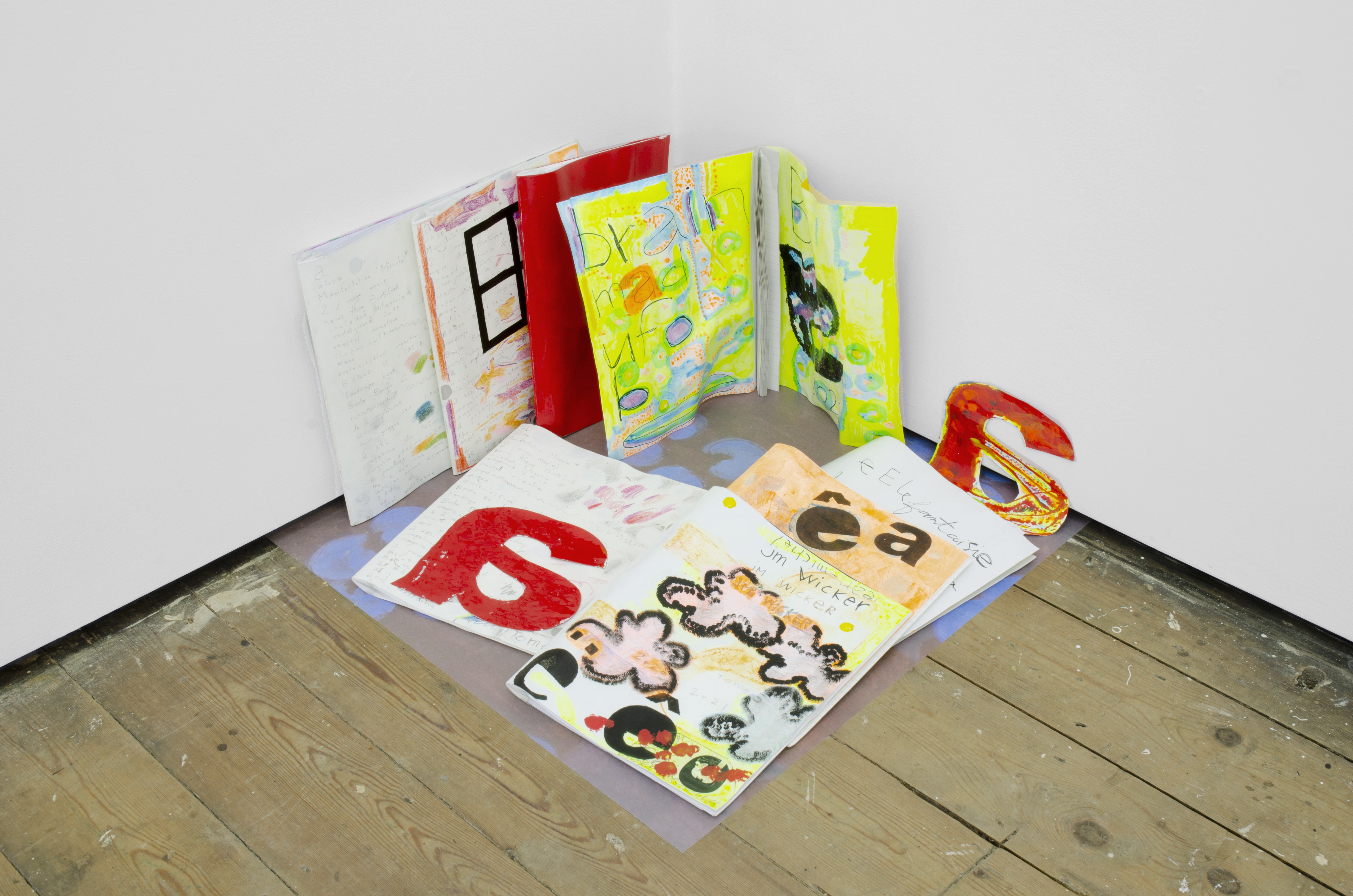the fairy paganist clubbing vvitch fffflying from club to club
Andrew Bracey finds Jean-Michel Wicker is using the space at TG to connect the viewer in an unexpected way, the emotional response and contemplation, becomes part of the experience.

installation view
Three ghosts sit at a table set for afternoon tea in Goodly Gory Ghost (1995) by French-born, Berlin-based artist Jean-Michel Wicker. Or rather, three seated people draped in white sheets with black circles in place of eyes, are at a table, that is also covered with a white sheet and a tea set. Tea is poured near the beginning, but mostly the mock-ghosts sit. The movement is slow and little action happens; slight movements suggest occasional conversations, but any sound is portentously absent. First impressions jump to Ku Klux Klansmen or Halloween, but these are too easy associations and neither feels right, white paradoxically also be indicative of purity, virtue and innocence. The meaning is slippery and elusive, perhaps even undesired, in encountering Wicker’s work. Instead of seeking to translate Wicker’s concepts, I pay attention to how I feel watching the film – concurrently calm, on-edge, agitated, transfixed, nervous, … The figures unsettle and absorb in equal measure and convey these emotions in me.

Christophe Terpent, Jean-Michel Wicker, Serge Comte, Vidya Gastaldon Goodly Gory Ghost, 1995
Playing on a loop with Goodly Gory Ghost is Paloma Beach (2007-9), which evokes a similar elusiveness. There is a hypnotic and mesmerising quality to the viewing, amplified by Sidney Stucki’s haunting music. Snippets of both b/w and colour 8mm footage of coastline has been collaged together. They are fragments of what could be archive or home-movie films, which have become free of an imposed narrative. I see captured moments pass by – rocks, sand, flora, walls, boats, trees, wind, tables, jetties, beaches, palms, hills, but most of all lapping waves. I am aware of how I pause and focus on being invited to be in time; a compression of time that invites the viewer to be present in the here and now through the mediative prompt of Wicker’s captured footage of time past.

installation view
An innovation of the display at TG is the mirroring and doubling of the films. A flatscreen opposite the doorway faces a smaller, older screen hung low down on the white wall, both playing the same film in harmony. The older technology is hard to ignore as one watches and this informs the viewing experience; it makes it appear out of (this) time, inviting the past and present to be brought together. Turning 180 degrees to watch the screen on the opposite side one notices that it exactly matches the size of the window in front of which it is placed. This unusual siting makes the viewing both difficult and peculiarly attuned, as the eyes attempt to adapt to factors beyond the films such as the outdoor light and view of terraced houses. The external environment impinges onto and informs the viewing of the film. The different times and weather conditions enlighten and shift the individual’s unique experience of watching the films. For me, the intrigue of this particular display rests on the pivot as one turns from screen to screen; attempting and failing to behold the exact same moment of the film. The attempt to do so appears to be encouraged, the belief that it may be possible is frustratingly denied.

Jean-Michel Wicker, sculpture club (part of camouflage classe) 2021-2022
The films are accompanied by drawings and artists’ books. sculpture club (part of camouflage classe) (2021-22) is a collection of eight handmade books arranged atop a digital print on the floor. The choice to display the books like this instead of a table or chair suggests that the artist is taking the viewer out of their comfort zone, challenging the unexpected as part of the experience of the work. In the second room, twenty-one A4 drawings mounted behind glass make up Que quoi comment écrire après LXIR ? (2021). Many of the drawings feature the title of the work written roughly in felt tip or pencil, alongside repeated motives of red clouds, the letter ‘a’ and abstract, gestural marks. The drawings appear to be an invitation, the title translates as ‘what to write after LXIR?’. I learn from the accompanying text by Julien Laugier that LXiR is an experimental novel by Guillaume Dustan, that the writer gave to the artist. Wicker’s responses appear to suggest multiple possibilities outside of verbal and linear language towards intuition, repetition, reduction and imagination.

Jean-Michel Wicker, que quoi comment écrire après LXIR ? 2021
Hidden inside the top drawer of a plan chest are two books published to accompany previous exhibitions, including one from Wicker’s previous UK solo show at Cubitt, London in 2014. Their content is indicative of the artist’s practice as a whole. Pages are filled with interviews, (concrete) poetry, multiple repetitions of the letters ‘a’ and ‘e’, emojis, collages, found images, but the overriding memory is of the blank pages that populate the majority of the books. They simultaneously allow the surrounding content to breathe, as well as allowing other thoughts and possibilities to be conjured. The confidence to allow so much ‘empty’ space is indicative of what I found so profound in encountering Wicker’s show as a whole – only three of the eight walls in the two gallery rooms were used. The work and the nature of the display allows pauses, which encourage at least this viewer to pause in the moment. Wicker is an artist who straddles openness and intuition with precision and discipline, a tricky balancing act to achieve and one that is fulfilling to encounter.
Exhibition closes 9 April 2022
http://www.tgal.co
18 March 2022

